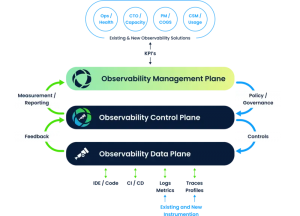Hyperscale’s new kids have a few tricks to teach the Enterprise | #IBMEdge
![]() Companies like Amazon, eBay, Facebook and Google have pioneered the notion of a hyperscale operation. They have mastered available technologies to solve problems specific to their day-to-day operation. With these and other companies as the example states Swamy Kocherlakota, Managing Director of Infrastructure and Architecture for BNY Mellon, a large financial services organization, enterprise of the future will take the lessons learned and use them to transform themselves similarly.
Companies like Amazon, eBay, Facebook and Google have pioneered the notion of a hyperscale operation. They have mastered available technologies to solve problems specific to their day-to-day operation. With these and other companies as the example states Swamy Kocherlakota, Managing Director of Infrastructure and Architecture for BNY Mellon, a large financial services organization, enterprise of the future will take the lessons learned and use them to transform themselves similarly.
With their legacy of investment and innovation, Kocherlakota believes vendors like IBM are at the forefront of the revolution, able to exploit their existing elements for the creation of a market-ready product aimed at helping those enterprise customers ready to make the leap to a software defined storage solution.
Kocherlakota states one major difference between the Googles and Facebooks of the world, and traditional enterprise is that the aforementioned companies have the luxury of having only to focus on doing one thing, such as search, and running that at scale. BNY Mellon and other enterprise operations, on the other hand, have a wider focus with each component having to run at scale.
Kocherlakota does see value in the path forged by the current hyperscale set stating, “We look to those companies to see what they do and what we can apply in our own operations.”
Watch theCUBE interview in its entirety here:
.
Crediting the growing acceptance of open source by the Enterprise, Kocherlakota believes the entire mindset of Enterprise IT is currently in flux. The previous model of IT would spend to solve issues, knowing that outlay would benefit them in time saved. In the case of BNY Mellon, they are now engineering on open source and on a single stack.
“Our developers can write to the stack and it will scale. The days where we turn to vendors like IBM for every single answer are gone,” he stated.
The shift to problem solving in-house will, according to Kocherlakota, bring about a significant increase in the speed of innovation within the organization. “Working with a vendor and being part of their product roadmap and working with their product team…is more time consuming than adopting an open source technology.”
The import of IBM as a preferred vendor for BNY Mellon is not diminished as enterprise moves to open source solutions, however. “The core engine of the technology can be open source,” he stated. “But you need an ecosystem around that. You can have a turbo engine, but you still need the leather seats.” Kocherlakota continued, “We look for vendors like IBM for a management suite around it so we can managed the complexity of our environment when it deploys open source technology at scale.”
Across the enterprise, the trend has been noted that IT budgets have flattened out are are even being cut. Open source technology seems suited to this pared down budgetary landscape. Kocherlakota claims the price drops inherent in the technology allow for IT to utilize those savings for new innovations. Additionally, IT is beginning to be viewed less as a cost center and more a profit-driver for organizations thanks to these re investments into the company.
As Kocherlakota notes, IT budgeting and any innovations expected from IT were previously planned top down within the company. The shift, thanks to cost saving innovations and price drops, is IT funding that is derived within the department.
One of the more important turn of events with the shift to software-defined data centers is how the proprietary language of IT by practitioners within the enterprise is being replaced. No longer is it “My server. My Network. My Storage.” As Kocherlakota states, “Everything is virtual, automated and elastic.”
Where once hardware was provisioned and deployed, at substantial cost, based on projected growth, the software defined data center is able to be deployed for today’s needs and not the possible expected needs some 20 years down the road. “We will give [servers, networks and storage] to IT when they want it so they can be smarter about how they use it,” he concluded.
photo credit: pixabay
A message from John Furrier, co-founder of SiliconANGLE:
Your vote of support is important to us and it helps us keep the content FREE.
One click below supports our mission to provide free, deep, and relevant content.
Join our community on YouTube
Join the community that includes more than 15,000 #CubeAlumni experts, including Amazon.com CEO Andy Jassy, Dell Technologies founder and CEO Michael Dell, Intel CEO Pat Gelsinger, and many more luminaries and experts.
THANK YOU













